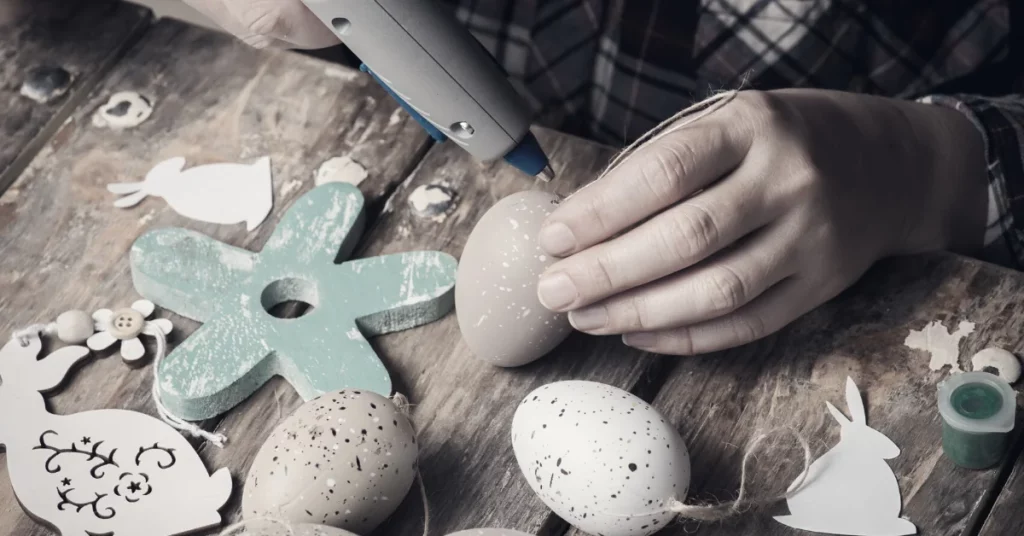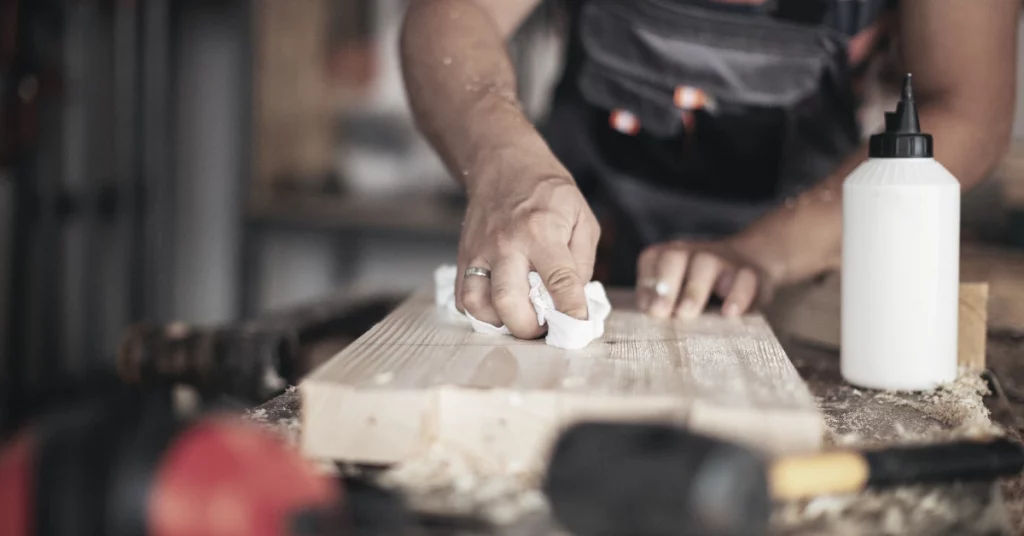If you’re looking to make some household repairs or fixes, multiple types of Glue are available that fit your purpose, depending on a few factors. Hot Glue and Wood Glue are two standard household types you can get with multiple uses.
Even though both of these are adhesives to bond and attach two or more components, they function quite differently from each other.
So, in the debate between Hot Glue vs. Wood Glue, which one should you side with? I’ll go over their features, materials they work well with, and more, as well as differences in this article.
Read More: Hot Glue Vs. Super Glue
Hot Glue vs. Wood Glue
What is Hot Glue?

Hot Glue is the generic term for various available Hot-melt Adhesives (HMA) and forms a bond when you apply heat to the adhesive. Hot Glue is thermoplastic; you need to use a hot glue gun to apply heat to the surfaces once you set them.
Hot Glue works well with a range of materials like – Paper, Wood, Plastics, Ceramic, Fabric, Glass, and more. You can use Hot Glue for various repairs and fixes around the house, like – installing trim or gaskets, assembling cabinets or panels, encapsulation or wire tacking, case closing, wrapping, and more.
Hot Glue is thermoplastic and not water-based like many other alternatives, making it stronger than water-based adhesives. Furthermore, Hot Glue is usually polymer-based, so you can mix and customize it to work well with many materials.
Hot Glue is also quick drying, so if you’re in a rush, Hot Glue can be an excellent choice. Hot Glue dries and cures fast; when you apply heat, it melts and forms a bond when it gets cold.
Hot Glue is also an excellent choice for materials in a comparatively humid environment since the glue layer Hot Glue forms are resistant to water and moisture.
Read More: Hot Glue Vs. Gorilla Glue
What is Wood Glue?
Wood Glue is the generic name for a range of Glue typically meant for woodworking. Wood Glue is usually composed of Polyvinyl Acetate (PVA), but you can find some wood glues made of – Epoxy, Polyurethane, or Hide Glue.
Wood Glue is water-soluble and only works with porous materials. Wood Glue wood works excellent with wood, as the name suggests. Besides Wood, Wood Glue would still work with other porous materials like – Paper, Foam and will not work with smooth, non-porous materials like Glass or Metal.
Wood Glue has a long drying and set time. Once you apply the Glue, it will take from 5 to 20 minutes to start to dry. After that, a complete cure would take around an entire day. However, Wood Glue has strong bonding capabilities and forms a permanent, long-lasting bond once wholly cured.
You can also use Wood Glue to fill gaps in all sizes of wood. You can fill small holes in wood with Wood Glue for effective results; if the gap size is more extensive, you may need to use some sawdust alongside Wood Glue.
Using either Polyvinyl Acetate (PVA) or Polyurethane based Wood Glue would give you a long-lasting, permanent bond between the surfaces.

Read More: Hot Glue Vs. E6000
Differences Between Hot Glue And Wood Glue
Now that I’ve reviewed what Hot Glue and Wood Glue offer, let’s examine their differences.
Suitable Materials
Hot Glue works well with materials like – Paper, Wood, Plastics, Ceramic, Fabric, Glass, etc.
Wood Glue works well with Wood and other porous materials like Paper.
Dry Time
Hot Glue has one of the fastest drying times. Depending on the amount used, Hot Glue will take less than a minute to about 10 minutes to start to dry.
On the other hand, Wood Glue takes around 20 minutes to start to dry, with a complete cure taking up to 24 hours.
Health Hazard
Hot Glue produces fumes when working with it since you have to apply heat to form a bond. However, the fumes aren’t usually toxic. Furthermore, it would help if you kept aware while working with Hot Glue since it can cause burns on your skin.
Wood Glue does not have such health concerns.
Cleaning
Since Hot Glue dries very fast, you need to clean any extra residue fast before it dries out.
With Wood Glue, you have time to clean the residues after applying since it dries slower.
Read More: Wood Glue vs. White Glue
How permanent is hot glue?
It may not be as permanent on non-porous surfaces or under extreme temperatures.
Other types of adhesives might be more appropriate for a more durable bond. Always handle hot glue guns carefully to avoid burns.
Is hot glue strong?
However, its strength can depend on the types of materials being bonded and the conditions in which the bond is placed.
While it works well with porous materials such as fabric, wood, and paper, it may be less effective on non-porous surfaces like certain plastics, glass, or metal.
Its bond can also weaken in extreme temperatures. Nonetheless, hot glue provides a sufficient and durable adhesive solution for many craft and household uses.
Last Opinion
So which one should you go for in the Hot Glue vs. Wood Glue debate? Wood Glue will be a superior choice if you’re working with wood and big chunks of Wood.
On the other hand, if time is an issue and the materials you’re working with are Plastic, Paper, Paper, or Wood (smaller pieces), you can go with Hot Glue.

